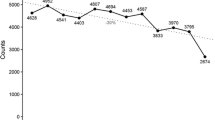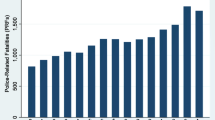Abstract
Objective
To assess the effect of civil gang injunctions on crime.
Methods
We use data on the location and date of 46 gang injunctions between 1993 and 2013 and quarterly crimes reported to the Los Angeles Police Department (LAPD) from 1988 to 2014. We estimate the effect of gang injunctions on crime over the short-term (20 quarters) and long-term (108 quarters) using difference-in-differences designs that take into account spatial and temporal correlation. Three gang injunctions were paused during the study period and provide a natural experiment from which we estimate the short-term effect of these injunctions on crime.
Results
Gang injunctions are estimated to reduce total crime 5% in the short-term and 18% in the long-term, most of the effect coming from reductions in assaults. Analyses of the three interrupted injunctions yielded estimates of similar magnitude, providing further support of a crime reduction effect of gang injunctions. We found no evidence that gang injunctions are associated with displacing crime to nearby areas.
Conclusions
Injunctions represent a powerful place-based intervention strategy for police and prosecutors. Courts have recently subjected gang injunctions to closer scrutiny. This study indicates that gang injunctions contributed to a meaningful amount of the crime reductions in Los Angeles. Future research should examine whether gang injunctions reduce crime by specific deterrent effects on individual gang members or by the general deterrent effect of placing an area under greater police surveillance and restricting public gatherings and other actions deemed to be indicators of gang activity.





Similar content being viewed by others
Notes
The Rampart investigation revealed criminal activity among some LAPD anti-gang unit officers (Lopez and Connell 1999). Several implicated officers had been involved in the establishment of two of the injunctions (O’Deane 2012). For the third case, at the same time the dismissal was occurring, LACA was already in the process of establishing a second MS-13 gang injunction in the Rampart area. When the court dismissed the original MS-13 injunction, LACA added the safety zone from the dismissed case to the new injunction (personal communication with LACA). All three injunctions were later reestablished when the LACA refiled complaints with new evidence.
Grand theft person, listed under California PC 487(c), is the theft of property of value directly off another person without force or threat of force.
For identification to hold, we need to condition on the calendar time periods corresponding to the relative time periods for each injunction. We leave this conditioning implicit here in order to reduce notation clutter. We explicitly deal with calendar time in the estimation section.
This is true for all but the last two injunctions listed in Table 5. Since our sample period ends with the fourth quarter of 2014, we have six quarters of follow-up data for the 6-Gang Glendale Corridor injunction and seven quarters for the Columbus Street injunction.
http://assets.lapdonline.org/assets/pdf/Org%20Chart%204-27-17-DP-4B.pdf. Accessed 10 Aug 2017.
The three injunctions that underwent a temporary disruption were Shatto Park (Case Number BC190334), Pico Union I (Case Number BC175684), and Mara Salvatrucha (MS13) I (Case Number BC187039).
For each of the three interrupted injunctions, RDs associated with the Southwest (Case Number BC167915) injunction constituted the only continuously enjoined comparison RDs. The Southwest injunction was continuously in effect concomitant with the complaint-suspend-reinstate time periods for all three treatment injunctions. Furthermore, the Southwest RDs were not too far away from the Shatto Park, Pico Union I, and MS13 I RDs and provide a useful comparison.
In addition to the variables shown, all regressions included calendar quarter dummies to control for general time trends and seasonal patterns.
References
2003–2004 Los Angeles County Civil Grand Jury (2004) Final report. Los Angeles County, Los Angeles
Bertrand M, Duflo E, Mullainathan S (2004) How much should we trust differences-in-differences estimates? Q J Econ 119(1):249–275
Bester CA, Conley TG, Hansen CB (2011) Inference with dependent data using cluster covariance estimators. J Econ 165(2):137–151
Braga A, Weisburd D (2010) Policing problem places: crime hot spots and effective prevention. Oxford University Press, New York
Cook PJ, MacDonald JM (2011) The role of private action in controlling crime. In: Cook PJ, Ludwig J, McCrary J (eds) Controlling crime: strategies and tradeoffs. University of Chicago Press, Chicago
Deane G, Messner SF, Stucky TD, McGeever K, Kubrin CE (2008) Not ‘islands, entire of themselves’: exploring the spatial context of city-level robbery rates. J Quant Criminol 24(4):363–380
Eicker F (1967) Limit theorems for regression with unequal and dependent errors. In: Proceedings of the fifth Berkeley symposium on mathematical statistics and probability. University of California Press, Berkeley, pp 59–82
Esbensen F-A (2013) Civil gang injunctions. Criminol Public Policy 12(1):1–4
Fagan J, MacDonald JM (2012) Policing, crime and legitimacy in New York and Los Angeles: the social and political contexts of two historic crime declines. In: Halle D, Beveridge AA (eds) New York and Los Angeles: the uncertain future. Oxford University Press, New York, pp 219–262. https://doi.org/10.1093/acprof:oso/9780199778386.003.0008
Gibbs J (1975) Crime, punishment, and deterrence. Elsevier, New York
Goff K (2013, September 14) Sylmar, Pacoima helped by injunction, authorities say. Los Angeles Daily News
Grogger J (2002) The effects of civil gang injunctions on reported violent crime. J Law Econ 45(1):69–90
Hennigan KM, Sloane D (2013) Improving civil gang injunctions: how implementation can affect gang dynamics, crime, and violence. Criminol Public Policy 12(1):7–41. https://doi.org/10.1111/1745-9133.12000
Huber PJ (1967) The behavior of maximum likelihood estimates under nonstandard conditions. In: Proceedings of the fifth Berkeley symposium on mathematical statistics and probability. University of California Press, Berkeley, pp 221–233
Kennedy D (2009) Deterrence and crime prevention: reconsidering the prospect of sanction. Routledge, London
Klein MW (1995) The American street gang. Oxford University Press, New York
Leovy J (2015) Ghettoside: a true story of murder in America. Spiegel & Grau, New York
Lopez RJ, Connell R (1999, September 21) Police probe forces suspension of rampart anti-gang injunctions. Los Angeles Times
Los Angeles City Attorney (2016, March 9) List of gang injunctions. http://www.lacityattorney.org/gang-injunction. Accessed 9 Mar 2016
Los Angeles Times Editorial Board (2013, November 7) Be wary of gang injunctions. Los Angeles Times. http://www.latimes.com/opinion/editorials/la-ed-gang-injunction-city-of-orange-rackauckas-20131107-story.html. Retrieved 28 Feb 2017
MacDonald JM, Hipp JR, Gill C (2013) The effects of immigrant concentration on changes in neighborhood crime rates. J Quant Criminol 29(2):191–215
Maxson C, Hennigan K, Sloane D (2005) “It’s getting crazy out there”: can a civil gang injunction change a community? Criminol Public Policy 4(3):577–606. https://doi.org/10.1111/j.1745-9133.2005.00305.x
Maxson CL, Matsuda KN, Hennigan K (2011) “Deterrability” among gang and nongang juvenile offenders: are gang members more (or less) deterrable than other juvenile offenders? Crime Delinq 57(4):516–543. https://doi.org/10.1177/0011128709343137
Melde C (2013) The practicalities of targeted gang interventions. Criminol Public Policy 12(1):43–48. https://doi.org/10.1111/1745-9133.12004
Nagin D (2013) Deterrence in the twenty-first century. Crime Justice 42(1):199–263
O’Deane MD (2012) Gang injunctions and abatement: using civil remedies to curb gang-related crimes. CRC Press, Boca Raton
Order Granting Plaintiffs’ Motion to Expand Preliminary Injunction in Youth Justice Coalition, et al vs. City of Los Angeles, CV 16-07932 VAP (RAOx) (United States District Court, Central District of California March 15, 2018). https://www.aclusocal.org/sites/default/files/aclu_socal_yjc_v_la_20180315_order_granting_mtn_expand_pi.pdf
Papachristos AV (2013) The importance of cohesion for gang research, policy, and practice. Criminol Public Policy 12(1):49–58. https://doi.org/10.1111/1745-9133.12006
Ridgeway G, MacDonald JM (2016) Effect of rail transit on crime: a study of Los Angeles from 1988–2014. J Quant Criminol. https://doi.org/10.1007/s10940-016-9296-7
Rubin J, Reyes E (2016, March 16) L.A. to pay up to $30 million in curfew lawsuit settlement to provide job training for gang members. Los Angeles Times
Superior Court of California, County of Los Angeles (2016, March 9). http://www.lacourt.org/casesummary/ui/index.aspx?casetype=civil
Tita GE, Radil SM (2010) Spatial regression models in criminology: modeling social processes in the spatial weights matrix. In: Piquero A, Weisburd D (eds) Handbook of quantitative criminology. Springer, New York, pp 101–121
Tita G, Ridgeway G (2007) The impact of gang formation on local patterns of crime. J Res Crime Delinq 44(2):208–237
Wang C (2008) Gang injunctions under heat from equal protection: selective enforcement as a way to defeat discrimination. Hastings Const Law Q 35:287–308
White H (1980) A heteroskedasticity-consistent covariance matrix estimator and a direct test for heteroskedasticity. Econometrica 48:817–830
Author information
Authors and Affiliations
Corresponding author
Appendix
Rights and permissions
About this article
Cite this article
Ridgeway, G., Grogger, J., Moyer, R.A. et al. Effect of Gang Injunctions on Crime: A Study of Los Angeles from 1988–2014. J Quant Criminol 35, 517–541 (2019). https://doi.org/10.1007/s10940-018-9396-7
Published:
Issue Date:
DOI: https://doi.org/10.1007/s10940-018-9396-7




